Guitar effects pedals are units that are designed to produce various sounds and tones by altering the original guitar sound. 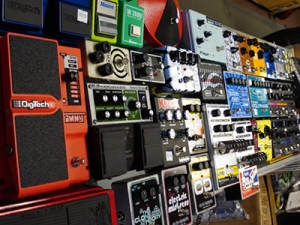
They come in many shapes and sizes and vary from, stand alone analog "stomp boxes", to complex digital units with numerous built-in multiple effects.
Most guitar effects pedals are built with a foot switch so they can be activated when placed on a floor or stage.
They are accessed by plugging the guitar directly into them and then routed to the guitar amp, or can also be routed through the effects loop of an amplifier.
Effects pedals are designed to produce many various sounds and tones on the guitar. Here are a few of the more common ones.
Distortion
 Distortion is an "over driven" sound that is created on a guitar amp by pushing the guitar channel to its fullest while adjusting the volume with a master volume control.
Distortion is an "over driven" sound that is created on a guitar amp by pushing the guitar channel to its fullest while adjusting the volume with a master volume control.A distortion pedal produces the same effect in a pedal unit and is adjustable. Distortion is used extensively in rock, heavy rock, metal and some blues music.
There are many different types of distortion pedals available including overdrive, tube, fuzz and high gain pedals.
Chorus
Chorus is a "modulating" effect that produces a "sweeping" sound. It adds a shimmering effect to the guitar tone and is used extensively in many genres of music.A variation of a chorus sound is a flanger. The flanger is a more of a "swooshing" sound and, although popular, is not used as widely as a chorus.
Delay
A delay pedal produces an echo or slap back effect. Delay is in the same family as reverb, but is actually a "shortened" reverb.The delay effect is changed by adjusting the delay "time" and "repeats" to produce the desired "slap back".
Wah

A variation of the wah pedal is the "envelope filter", also known as an auto-wah. This pedal produces the wah effect automatically each time a note is picked and varies the amount of wah according to the attack of the note.
Compression
Compression acts to smooth the sound of the guitar by putting a "ceiling" on the transient peaks that a guitar normally produces. The "ceiling" is adjustable and many compressor pedals include a "noise gate" which filters out extraneous noise guitars can produce.Compression pedals are very effective on guitars with single coil pickups, like Strats, for smoothing sound and boosting signals.
Octave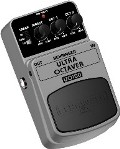
An octave pedal or "octave divider", takes an original signal and reproduces an octave of that note, which plays simultaneously with the original note.The octave note can be set to be an octave higher than the original note, or an octave lower.
This is a neat effect when used sparingly, but not something you would use on every song.
Pitch Shifting
Pitch Shifters can reproduce at note, in addition to the original note, that is at a variable pitch in relation to the original. It is used primarily to produce the sound of two guitars playing in harmony with each other.These units can be set to the key the song is being played in and adjusted to produce various intervals of the original note such as 3rd's, 5th's, 7th's etc.
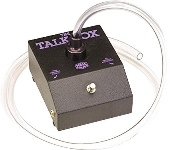 Talk Box
Talk Box
A talk box produces a sound that is similar to the human voice. The guitarist holds a tube in their mouth and talks, which shapes the sound through air that is pushed from an amp speaker when the unit is connected through the output of the amp.Although the talk box has been around since the 1940's, it really came into popularity with Peter Frampton in the '70's. It can be heard on songs like "Show Me the Way" and Joe Walsh's "Rocky Mountain Way".
Multi Effects Pedals
There are many effects pedals on the market that contain a combination of various guitar effects all in one unit. These are popular because they can be space saving and money saving as well.
With single effect pedals starting in the $20 range and up, the investment in a number of these pedals can be substantial, making the multi effects pedal attractive.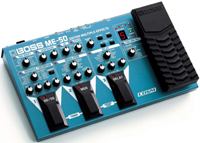
(Editors Note: This is not a product endorsement - but after spending a small fortune on effects pedals for nearly 30 years, I finally discovered the Boss ME-50 multi-effects pedal and I love it! It has great distortions, delays, choruses, modulators, a tuner and, best of all, it's easy to use. Highly recommended for "old school" players)
Choosing Effects Pedals
With the vast number of stomp boxes, multi effect and rack mount units available, it can be difficult, and costly, to experiment.
If you are early in the guitar playing process and don't want to break the bank, a recommendation would be to go with a good distortion pedal and maybe a chorus pedal as well. These are two pedals that will have many applications and get a lot of use.
Other effects such as Wah, Flange, Delay, Pitch Shifting, Talk Boxes etc. are "icing on the cake" effects that will only be needed occasionally. You may consider adding some of these later.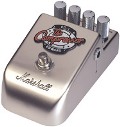
Either way, please keep in mind that effects pedals are meant to "enhance" your guitar playing, they are not something your guitar playing should "rely" on.
By coloring the sound, effects pedals have a way of "covering" mistakes and many new players end up using effects pedals as a crutch, rather than a tool.
The key is to use them sparingly and focus first and foremost on learning how to "play" the guitar.
Please do not hesitate to contact us with any questions!
![]()

